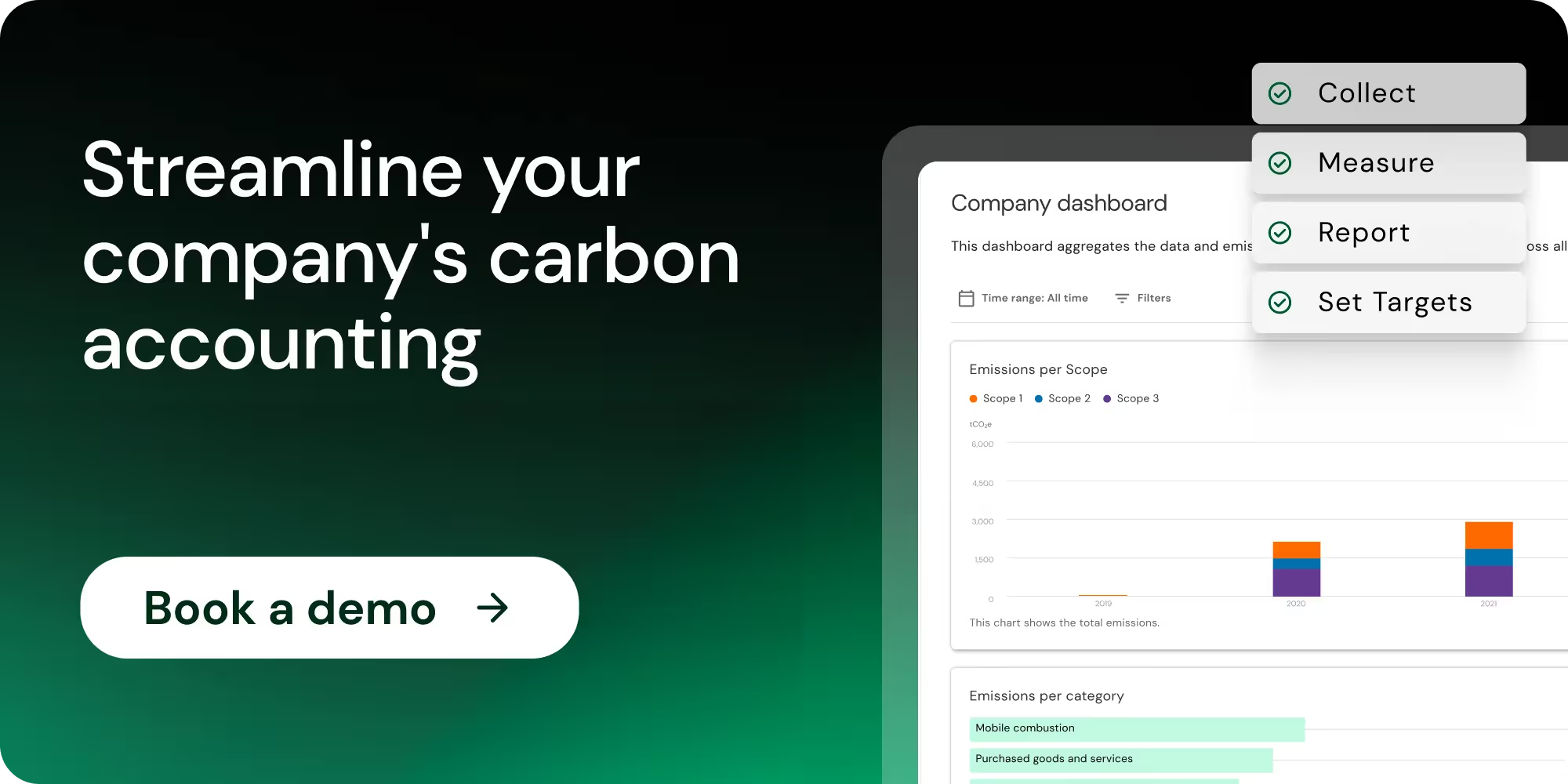As the world transitions towards a low-carbon economy, businesses of all sizes are committing to sustainable practices. The need to decarbonise is not just the domain of large corporations. Small and Medium Enterprises (SMEs) are expected to do their part. This shift is being propelled by both the escalating impacts of climate change and stringent sustainability requirements big companies are now setting for their supply chains.
Large corporations demand that their suppliers, including SMEs, adhere to specific environmental standards. This includes the achievement of carbon reduction targets. Therefore, SMEs must view decarbonisation not merely as corporate responsibility but as a strategic business move. A shift that can bolster their position in the supply chain and potentially tap into new markets.
To support SMEs on this journey, Plan A has created an article to help SMEs decarbonise their businesses in 10 steps.
Key characteristics of SMEs
The nature of SMEs in Europe is such that they are generally found in sectors of the economy that emit less, compared to heavy industries dominated by larger companies. This inherent clustering is a primary reason for their reduced carbon emissions. However, this doesn't mean SMEs should rest on their laurels. The evidence from Europe for instance points out that SMEs consume energy intensively, suggesting a vast arena for sustainable enhancements.
Notably, European SMEs differ due to structural differences and varied definitions. In general, most SMEs are less involved in high-polluting industries compared to their UK counterparts. However, the skewed sectoral distribution implies that while they may emit less compared to more prominent companies, there's still significant room for environmental improvement.
How to decarbonise SMEs?

Credit: Plan A
1. Reimagine decarbonisation as a revenue generator
Progressive businesses have pivoted from viewing decarbonisation as a mere expense for leveraging it as a novel revenue avenue. This paradigm shift involves re-engineering products to minimise raw material usage, incorporating carbon as a product ingredient, or instituting measures to monetise waste. Preeminent corporations like Tesla have lucratively ventured into the carbon credits domain, while companies such as Rabobank are pioneering 'carbon banking'. The takeaway? Decarbonisation, with its vast potential, could very well be the next corporate frontier.
2. Understand your baseline emissions
Start by understanding your carbon emissions. To embark on the journey towards decarbonisation, SMEs must first measure their current carbon emissions. This baseline sets the foundation for setting achievable reduction targets. Below are the steps, key metrics, and actionable results associated with understanding baseline emissions.
Scope 1 emissions: Direct emissions
These emissions arise directly from sources owned or controlled by the company, such as boilers or company vehicles. They're generally the most visible and the ones businesses have the most control over.
Actionable steps
- Vehicle fleet analysis: Audit the total number of company vehicles, fuel types, average fuel consumption, and total miles driven in a given year.
- On-site fuel combustion: Record the type and quantity of fuels used in boilers, generators, and other equipment.
For example, an SME with a fleet of 10 gasoline-powered vehicles, averaging 20,000 miles each per year, could emit approximately 150 metric tons of CO2 annually (given average emissions of 0.0091 metric tons CO2 per gallon and average fuel economy). In comparison, a small boiler consuming 20,000 therms of natural gas annually might emit around 110 metric tons of CO2.*
*The exact values might vary based on the specific emission factors, fuel economy, and combustion efficiencies used.
Scope 2 emissions: Indirect emissions
These emissions result from purchased energy, typically electricity, used in the company's operations. While not directly emitted by the company, they're a result of its energy consumption choices.
Actionable steps:
- Electricity consumption audit: Monitor electricity bills over 12 months to get an accurate assessment of usage patterns and total consumption.
- Green energy providers: Investigate whether your electricity comes from renewable or non-renewable sources. Some providers offer a mix, with varying degrees of green energy.
For example, an SME operating in a standard office environment using around 50,000 kWh of electricity annually could be responsible for roughly 35 metric tons of CO2 if the electricity is sourced entirely from fossil fuels (given an average emission factor of 0.0007 metric tons of CO2 per kWh). If the same SME sources 50% of its electricity from green energy providers, the emissions could be reduced by half, thus saving around 17.5 metric tons of CO2 annually.*
* The calculations demonstrate how indirect emissions from electricity consumption can be estimated. The exact values might vary based on the specific emission factors and the mix of energy sources from the electricity provider. The example emphasises the impact of sourcing electricity from green energy providers, which can significantly reduce a company's carbon footprint.
Scope 3 emissions: The lion's share of emissions
These include emissions from the lifecycle of products, employee commuting, business travel, waste disposal, and more. They represent a more extensive view of a company's carbon responsibility.
Actionable Steps:
- Supplier audits: Engage with key suppliers to understand their carbon footprints.
- Employee commute survey: Gather data on how employees get to work to measure the carbon footprint of commuting.
- Business travel tracking: Log all business-related travel by air, rail, or road.
- Waste assessment: Measure and categorise waste produced, focusing on non-recyclable waste.
For example, an SME that sources materials from an international supplier might find that the transportation of those materials contributes 100 metric tons of CO2 annually. If employees predominantly commute using gasoline-powered cars, this could add another 50 metric tons of CO2 yearly. Business trips, depending on frequency and mode of transportation, might add a variable amount, say 20 metric tons of CO2.
With an understanding of emissions across all three scopes, SMEs can better strategise comprehensive decarbonisation. It's often the less obvious Scope 3 emissions that, when addressed, can yield significant sustainability gains. Whether it's through greener procurement policies, promoting remote work, or waste reduction initiatives, every step towards reducing these emissions moves the company closer to a sustainable operational model.

3. Setting targets for reduction
Post-baseline establishment, target-setting becomes pivotal. Components for a thorough decarbonisation roadmap comprise:
- Scopes of emissions: Begin with Scopes 1 and 2 since they're majorly under the company's control. Scope 3 emissions, being more intricate, usually come later in the strategy.
- Base year: A recent 12-month frame with reliable data to compare against future GHG emissions.
- Target year: The anticipated year by which emissions reduction targets should be achieved.
- Percent reduction: The aimed reduction percentage from the base year to the target year.
Moreover, targets can be absolute (total emissions reduction) or intensity-based (emissions per unit of output). SMEs should align their targets with those of their large corporate clients, understanding these through sustainability reports.
4. Optimise internal processes
Reducing carbon emissions within an SME's immediate control is vital. Here's how you can refine and elevate your internal operations without leaning on electric vehicles (EVs) or duplicating prior insights:
On-site energy management:
- Adopt energy-efficient practices: Transition to machinery and devices that operate at optimum energy levels, ensuring less energy consumption and wastage.
- Timed energy systems: Use automated systems such as intelligent sensors to guarantee lights and equipment are operational only during necessary periods.
- Routine maintenance: Regular equipment checks can ensure machinery is operating efficiently, using less power, and reducing chances of wear that can increase energy consumption.
With energy-efficient machinery, companies might experience up to a 30% reduction in energy consumption. Automating energy systems, such as lighting, can save up to an additional 10% of energy costs.
Waste minimisation and process efficiency:
- Implement process audits: Detailed assessments can pinpoint inefficiencies and areas where waste can be minimised.
- Lean techniques: Integrate lean management practices to streamline operations and reduce waste.
- Champion recycling & reuse: Foster a culture where materials are recycled or reused within operations where possible.
For example, an SME conducting rigorous process audits can reduce waste by up to 40%. Thus, through effective recycling, up to half of the waste generated can be repurposed, drastically reducing the amount directed to landfills.
Remote work and digitalisation:
- Transition to cloud services: Utilising cloud computing can lessen the dependence on energy-consuming on-site servers.
- Promote virtual interactions: Embrace online meetings to curtail the emissions associated with business-related travel.
- Digital-first approach: Shift away from paper-intensive tasks by going digital, minimising the carbon costs linked with paper usage.
For example, moving to cloud solutions can cut energy usage linked to on-site servers by around 70%. Emphasising virtual meetings over physical travel can help in avoiding approximately 20 business trips annually, significantly cutting down travel-related emissions. By opting for a digital-first strategy, SMEs can reduce paper-associated carbon footprints by around 50%.
Streamlining internal processes goes beyond monetary savings. It's about adopting a proactive approach towards building an environmentally conscious and efficient business foundation. By rethinking energy use, and waste generation, and integrating digital solutions, SMEs can significantly reduce their direct carbon footprint and pave the way for sustainable growth.
5. Decarbonise your supply chain
SMEs often rely on suppliers for components, raw materials, or services. Selecting environmentally conscious suppliers can reduce an SME's indirect carbon footprint significantly. According to a study by McKinsey, 90% of companies' impacts on the environment come from supply chains rather than from their direct operations.
Actionable steps:
- Vendor audits: Evaluate the environmental practices of vendors.
- Sustainable sourcing: Prioritise materials that are sustainably sourced or have a lower carbon footprint.
- Local procurement: Opt for local suppliers to reduce transportation emissions.
6. Invest in employee education and training
Employees play a vital role in a company's sustainability journey. By creating a workforce that understands and values sustainable practices, SMEs can ensure a consistent approach to decarbonisation.
Actionable steps:
- Workshops and seminars: Host regular training sessions to educate employees about the importance of sustainability.
- Incentive programs: Offer rewards for sustainable ideas or initiatives.
- Green teams: Form committees or teams that focus on sustainability projects within the business.
7. Adopt circular economy principles
Moving away from the traditional 'take, make, dispose' model to a circular one, where resources are reused and recycled, can significantly reduce waste and associated emissions. The Ellen MacArthur Foundation suggests that European businesses can achieve a net benefit of €1.8 trillion by 2030 by adopting circular economy principles.
Actionable steps:
- Design for longevity: Create products that last longer and can be easily repaired or upgraded.
- Reuse and refurbishment: Encourage returning old products, which can then be refurbished and resold.
- Recycling initiatives: Set up systems to recycle waste products or by-products.
8. Transition to renewable energy
Transitioning to renewable energy sources is one of the most effective ways to decarbonise a business. With the declining cost of renewable technologies and various incentives available, SMEs can gradually reduce their reliance on fossil fuels.
Actionable steps:
- On-site renewable installations: Consider installing solar panels, wind turbines, or even biomass systems if feasible for your site.
- Purchase green energy: Opt for electricity supply contracts that source power from renewable generators.
- Participate in community energy projects: Join community solar or wind projects, which allow multiple stakeholders to share the benefits of renewable energy.
- Energy storage solutions: Invest in battery storage systems to store excess renewable energy, further reducing dependency on grid power.
The International Renewable Energy Agency (IRENA) reported that more than 50% of the renewable capacity added in 2019 achieved lower electricity costs than new coal. The global weighted average cost of electricity from solar power concentration fell by 13%, that of onshore wind dropped by 13%, and 33% for offshore wind, compared to the previous year.
With this approach, SMEs can directly contribute to the transition towards renewable energy, reducing their carbon emissions and potentially benefiting from energy cost savings in the long run.
9. Foster a culture of innovation
Decarbonisation requires innovative thinking. Creating an environment encouraging innovative ideas can lead to unique solutions tailored to the SME's needs. A report suggests that companies that embed sustainability into core business innovation have 20% more Return on Investment (ROI) than those that don't.
Actionable steps:
- Idea campaigns: Hold brainstorming sessions to come up with green solutions.
- Collaborative projects: Work with universities or think tanks to research sustainable practices relevant to your industry.
- Invest in green tech startups: Sponsor or invest in startups that align with your sustainability goals.
10. Regularly reassess and adapt strategies
The rapidly evolving sustainability landscape makes it essential for SMEs to constantly reevaluate and refine their decarbonisation strategies. With technological advancements and shifts in environmental policies, what was effective a year ago might not guarantee the same results today. Regular reassessment ensures that the business not only remains compliant but also optimises resources for the highest impact.
Actionable steps:
- Use carbon accounting software: Utilising specialised software can make it easier for SMEs to track, analyse, and report their carbon emissions. This will help identify areas of improvement and ensure accurate data collection for strategic decisions. For example, Plan A is Europe’s leading corporate carbon accounting, software provider and makes it seamless to measure your SME corporate carbon footprint (CCF).
- Quarterly reviews: Conduct detailed assessments every quarter to determine the effectiveness of sustainability measures. This could involve comparing emissions data, evaluating the return on investment for green initiatives, and tracking progress against set targets.
- Feedback loops: Establish an open channel where employees and other stakeholders can provide insights and feedback on implemented green practices. They often have firsthand experience with the strategies and can offer valuable perspectives on what's working and what's not.
- Stay informed: Dedicate resources to continuous learning. This can involve attending sustainability conferences, subscribing to industry journals, or even engaging with sustainability consultants to gain insights into emerging best practices and technologies.
According to the Harvard Business Review, companies that actively manage and strategically plan for climate change boost their ROI by up to 18% more than companies that don’t. Additionally, carbon accounting helps identify inefficiencies and wasteful practices that contribute to higher energy consumption and emissions, resulting in cost savings.
By maintaining an agile approach to decarbonisation, SMEs can stay ahead of the curve, capitalising on new opportunities, and ensuring that their sustainability efforts align with the best practices of the time.
The journey towards a decarbonised future is not just an imperative for large corporations but also a pressing responsibility for Small and Medium Enterprises. As demonstrated in this article, there are numerous low-hanging fruits SMEs can leverage for an immediate and substantial impact. By strategically implementing these steps, SMEs can not only contribute significantly to the global sustainability agenda but also unlock numerous business advantages - from cost savings to enhanced market positioning.
However, the road to effective decarbonisation requires both dedication and the right tools. To truly gauge, monitor, and enhance your carbon footprint, sophisticated digital solutions offer unparalleled advantages.
Are you an SME eager to make a tangible difference? Start today by understanding your carbon footprint better. Book a demo with Plan A now and discover how our platform can guide you through the intricacies of carbon accounting and enable you to spearhead sustainability initiatives with confidence.



.jpg)





